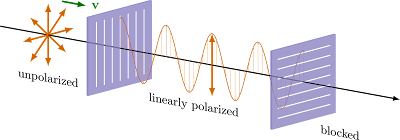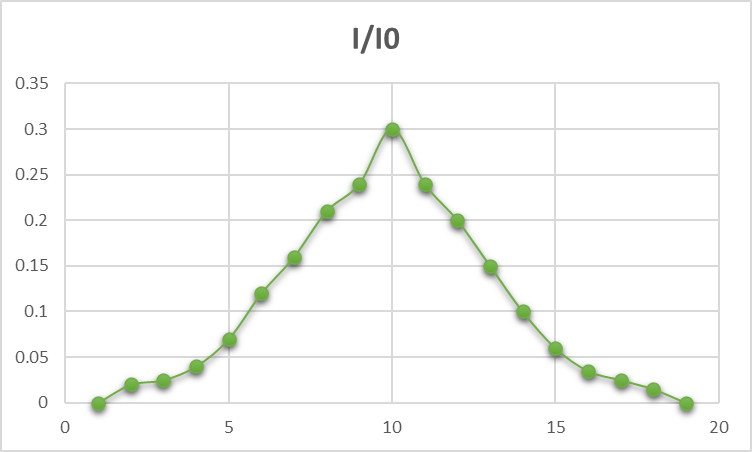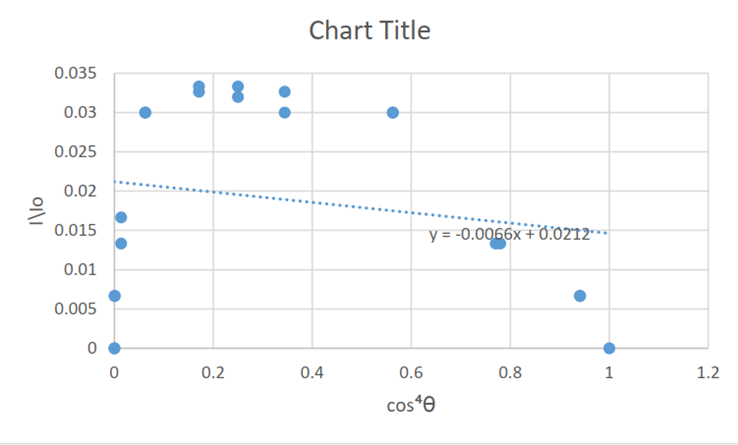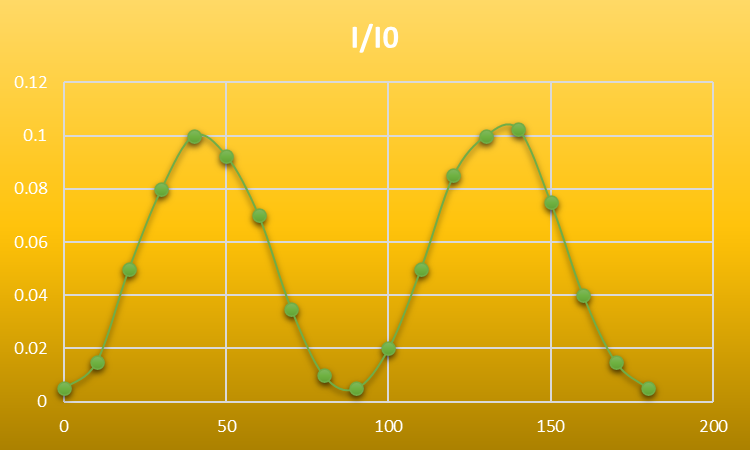Abstract
In this experiment you will study different
phenomena related to the polarization of photons. This experiment includes: The
study of the effects of two polarizers on the transmission intensity of
photons. The effect of a polarizer inserted between two crossed polarizers on
the transmission intensity of photons. The effect of a polarizer on the
transmission of circular polarization of photons. The effect of a circular
polarizer inserted between two crossed polarizers on the transmission of
photons.
Introduction
The nature of light
There has always been
disagreement over the nature of light since the seventeenth century. Newton and
his supporters used to say that the nature of light is a particle. This belief
prevailed for a period of time. After that, the wave theory appeared, which
says that the nature of light is wave, and this view was supported by some
experiments, such as the Yang experiment. Then came Maxwell's electromagnetic
theory, which deals with light as a wave consisting of an electric field and a
magnetic field. Maxwell developed the equations of his famous theory, and this
theory achieved great success.
However, with the
beginning of the twentieth century, strange phenomena began to appear that were
not obey to the classical theory of electromagnetism, such as the phenomenon of
photoelectric effect, the Compton phenomenon and others, which led to a
reconsideration of the nature of light so that scientists finally came to the
conclusion that light has a dual nature as stated in the research published by
the French physicist Louis de Broglie.
Energy flow and Poynting vector
It states that the time rate of flow of electromagnetic energy per unit area is given by the vector S, called the pointing vector defined as the cross product of the electric field and magnetic field divided by the vacuum permeability. It equals to the power over area.
In most cases, a time average of the power delivered per unit area is all that is required. This quantity is called intensity, I
The direction of the electric field vector is known as the polarization of the EM wave. Since the polarization supports the wave theory, we should understand it.
Linear Polarization
A polarizer selectively absorbs light or transmit it according to its transmission axis. The state of polarization of light can most easily be tested by a second polarizer which function as analyzer.
The intensity I of polarized light after passing through a polarizing filter can be detected by Mauls’ Law:
Circular, Elliptical Polarization and Quarter wave plate (QWP)
Circularly polarized light can be produced by introducing a phase shift of pi/2 between two orthogonal components of linearly polarized light. One device for doing this is known as quarter wave plate. These plates are made of doubly refracting transparent crystals, such as calcite of mica. Doubly refracting crystals have the property that the index of refraction differs for different directions of polarization.
The orientation of the quarter-wave plate is defined by the angle (Pi) between the transmission axis of the polaroid and the fast axis of the quarter-wave plate. By choosing ɵ to be 45 degrees, the light entering the quarter-wave plate can be resolved into two orthogonal linearly polarized components of equal amplitude and equal phase. Upon emerging from the quarter-wave plate, these two components are out of phase by Pi /2. Hence the emerging light is circularly polarized.
Polarized light can be represented by a Jones
vector, and linear optical elements are represented by Jones matrices. When
light crosses an optical element the resulting polarization of the emerging
light is found by taking the product of the Jones matrix of the optical element
and the Jones vector of the incident light. Note that Jones calculus is only
applicable to light that is already fully polarized. Light, which is randomly
polarized, partially polarized, or incoherent must be treated using Mueller
calculus.
Methodology
Apparatus
The apparatus consists of the following elements and devices, mentioned in order as will be seen in the experimental setup Figure below:
*Source: a
6 V AC incandescent lamp with housing.
*A
condenser lens to focus the light as will be discussed in the procedure.
* An iris
to limit the stray light
* An
additional lens may be used to obtain a parallel light beam. Another lens to
focus the parallel light beam on the photocell.
* A glass
filter to get a band of light preferably as small as possible.
* Optical
elements (polarizers, Quarter wave plate, and neutral density filters).
* A
photocell to detect the light photons.
*An
ammeter which can detect currents as low as few microamps.
* An optical bench to hold all the optical elements and devices.
Procedure
Part1: Using one polarizer
We turn on the light and control the Iris radius, then we put the polarizer and changed its angle from -90 to 90 and read the intensity from the micrometer.
Part2: Using two polarizers.
We set the first polarizer at angle 0 degree and changed the second one angle from -90 to 90 and recorded the intensity.
Part3 : 3 Polarizers
We arranged the 3 polarizers parallel to each other and set the 1st and the 3rd one at zero angle while changing the 2nd one angle from -90 to 90 degree.
Part4: 3 Polarizers
As the same setup in part3 but the 2nd one is changing from -90 to 90 and the third one stetted at zero angle.
Part5 : 2 Polarizers and QWP
At this part we replaced the 2nd polarizer with a QWP changing his angle from 0 to 180, the first polarizer at 0 degree, and the second at 90.
Part6: 2 Polarizers and QWP
Same setup as part5 but we set QWP at angle 45 and
changed the 2nd polarizer angle from
-90 to 90.
Data Analysis
Part 1
Is = 20 𝝁A
I when using one polarizer= I₀/2= 10𝝁A
Table (1)
|
θ |
I(10^-6)
A |
I/I0 |
|
-90 |
10.7 |
0.535 |
|
-80 |
10.8 |
0.54 |
|
-70 |
9.9 |
0.495 |
|
-60 |
9.9 |
0.495 |
|
-50 |
10.6 |
0.53 |
|
-40 |
10.6 |
0.53 |
|
-30 |
10.1 |
0.505 |
|
-20 |
10.4 |
0.52 |
|
-10 |
10.3 |
0.515 |
|
0 |
10.3 |
0.515 |
|
10 |
10.3 |
0.515 |
|
20 |
10.3 |
0.515 |
|
30 |
10.4 |
0.52 |
|
40 |
10.4 |
0.52 |
|
50 |
10.5 |
0.525 |
|
60 |
10.6 |
0.53 |
|
70 |
10.6 |
0.53 |
|
80 |
10.7 |
0.535 |
|
90 |
10.7 |
0.535 |
Figure1: shows the relation between
the intensities ratio and the angle using one polarizer.
For one polarizer, the light is linearly polarized with jones vector =
<I> = 9.905
Part 2
Using Two polarizers
First polarizer is fixed at 0 degree. The second polarizer is varied (-90- 90)
Table (2)
|
θ |
I(10-6)
A |
I/I0 |
Cos2
θ |
|
-90 |
0 |
0 |
0 |
|
-80 |
0.4 |
0.02 |
0.030154 |
|
-70 |
1 |
0.05 |
0.116978 |
|
-60 |
1.9 |
0.095 |
0.25 |
|
-50 |
3 |
0.15 |
0.413176 |
|
-40 |
4 |
0.2 |
0.586824 |
|
-30 |
4.9 |
0.245 |
0.75 |
|
-20 |
5.6 |
0.28 |
0.883022 |
|
-10 |
6.1 |
0.305 |
0.969846 |
|
0 |
6.3 |
0.315 |
1 |
|
10 |
6.2 |
0.31 |
0.969846 |
|
20 |
5.9 |
0.295 |
0.883022 |
|
30 |
5.3 |
0.265 |
0.75 |
|
40 |
4.3 |
0.215 |
0.586824 |
|
50 |
3.3 |
0.165 |
0.413176 |
|
60 |
2.3 |
0.115 |
0.25 |
|
70 |
1.2 |
0.06 |
0.116978 |
|
80 |
0.6 |
0.03 |
0.030154 |
|
90 |
0 |
0 |
0 |
Figure2: shows the
relation between the intensities ratio and the angle using 2 polarizers.
Figure3: shows the
relation between the intensities ratio and the square of the angle using two
polarizers.
The slope must equal to 1 between
cos²θ and I/I₀ theoretically but we obtained 0.3083 experimentally.
The linear polarized light emerges from the first polarizer.
The Jone matrix of polarizer with transmission axis at angle
θ with horizontal.
J.V= A , Where A is the Jone matrix representing
the final emerging light.
The flux intensity
Part 3
Polarizer inserted
between two parallel ones.
|
θ |
I(10^-6) A |
(cosθ)^4 |
I/I0 |
|
-90 |
0 |
0 |
0 |
|
-80 |
0.4 |
9.09*10^-4 |
0.02 |
|
-70 |
0.5 |
0.136838 |
0.025 |
|
-60 |
0.8 |
0.0625 |
0.04 |
|
-50 |
1.4 |
0.17071 |
0.07 |
|
-40 |
2.4 |
0.344363 |
0.12 |
|
-30 |
3.2 |
0.5625 |
0.16 |
|
-20 |
4.2 |
0.779728 |
0.21 |
|
-10 |
4.8 |
0.940601 |
0.24 |
|
0 |
6 |
1 |
0.3 |
|
10 |
4.8 |
0.940601 |
0.24 |
|
20 |
4 |
0.779728 |
0.2 |
|
30 |
3 |
0.5625 |
0.15 |
|
40 |
2 |
0.344363 |
0.1 |
|
50 |
1.2 |
0.17071 |
0.06 |
|
60 |
0.7 |
0.0625 |
0.035 |
|
70 |
0.5 |
0.136838 |
0.025 |
|
80 |
0.3 |
9.09*10^-4 |
0.015 |
|
90 |
0 |
0 |
0 |
Figure4: shows the relation between
the intensities ratio and the angle using 3 polarizers.
Figure5: shows the relation between
the intensities ratio and cosine to the power 4 of the angle using 3polarizers.
Part 4
Polarizer inserted
between two crossed ones.
|
θ |
I(10^-6) A |
(cosθ)^4 |
I/I0 |
|
-90 |
0.3 |
0 |
0.015 |
|
-80 |
0.5 |
9.09*10^-4 |
0.025 |
|
-70 |
0.8 |
0.136838 |
0.04 |
|
-60 |
1.2 |
0.0625 |
0.06 |
|
-50 |
1.45 |
0.17071 |
0.0725 |
|
-40 |
1.4 |
0.344363 |
0.07 |
|
-30 |
1.2 |
0.5625 |
0.06 |
|
-20 |
0.7 |
0.779728 |
0.035 |
|
-10 |
0.4 |
0.940601 |
0.02 |
|
0 |
0.3 |
1 |
0.015 |
|
10 |
0.5 |
0.940601 |
0.025 |
|
20 |
0.9 |
0.779728 |
0.045 |
|
30 |
1.3 |
0.5625 |
0.065 |
|
40 |
1.7 |
0.344363 |
0.085 |
|
50 |
1.6 |
0.17071 |
0.08 |
|
60 |
1.4 |
0.0625 |
0.07 |
|
70 |
0.9 |
0.136838 |
0.045 |
|
80 |
0.5 |
9.09*10^-4 |
0.025 |
|
90 |
0.1 |
0 |
0.005 |
Figure6: shows the
relation between the intensities ratio and the angle using 3 polarizers.
Figure7: shows the
relation between the intensities ratio and cosine to the power 4 of the angle
while using 3polarizers.
P.E = │(0.5-(-0.066))/0.5│ = 113%
Part 5
QWP inserted between
two crossed Polarizer.
|
θ |
I(10^-6) A |
I/I0 |
|
0 |
0.1 |
0.005 |
|
10 |
0.3 |
0.015 |
|
20 |
1 |
0.05 |
|
30 |
1.6 |
0.08 |
|
40 |
2 |
0.1 |
|
50 |
1.85 |
0.0925 |
|
60 |
1.4 |
0.07 |
|
70 |
0.7 |
0.035 |
|
80 |
0.2 |
0.01 |
|
90 |
0.1 |
0.005 |
|
100 |
0.4 |
0.02 |
|
110 |
1 |
0.05 |
|
120 |
1.7 |
0.085 |
|
130 |
2 |
0.1 |
|
140 |
2.05 |
0.1025 |
|
150 |
1.5 |
0.075 |
|
160 |
0.8 |
0.04 |
|
170 |
0.3 |
0.015 |
|
180 |
0.1 |
0.005 |
Figure8: shows the relation between the
intensities ratio to the angle while using
polarizers and QWP.
Jones matrix of QWP
at any angle is :
Part 6
Two polarizers the
first with 0 angle, second varies and QWP at 45 degree.
|
θ |
I(10^-6) A |
I/I0 |
|
-90 |
2 |
0.1 |
|
-80 |
2 |
0.1 |
|
-70 |
2.1 |
0.105 |
|
-60 |
2.3 |
0.115 |
|
-50 |
2.6 |
0.13 |
|
-40 |
2.8 |
0.14 |
|
-30 |
3.1 |
0.155 |
|
-20 |
3.3 |
0.165 |
|
-10 |
3.4 |
0.17 |
|
0 |
3.5 |
0.175 |
|
10 |
3.5 |
0.175 |
|
20 |
3.3 |
0.165 |
|
30 |
3.2 |
0.16 |
|
40 |
2.9 |
0.145 |
|
50 |
2.6 |
0.13 |
|
60 |
2.4 |
0.12 |
|
70 |
2.2 |
0.11 |
|
80 |
2 |
0.1 |
|
90 |
2 |
0.1 |
Figure9: shows the relation between the
intensities ratio and the angle using polarizers and QWP.
Conclusion
§ The
light propagates as a wave and interact with matter as a particle
(particle-wave duality).
§ Any
interaction of light with matter whose optical properties are asymmetrical
along directions transverse to the propagation vector provides a means of polarizing
light.
§ In
this experiment we use both the quantum theory and the classical theory of
light.
§ The
light is a transverse electromagnetic wave which consist of electric and
magnetic components which are both perpendicular on the direction of
propagation.
References
1- Third Edition, Introduction to Optics, PEDROTT.
2- Practical physics (0342411) manual.
3- https://tikz.net/files/optics_polarization-002.png



.png)
.png)






.png)
.png)


.png)
.png)
.png)
.png)
.png)
.png)




.png)

.png)

.png)
Comments
Post a Comment
If you have any comment please write it down, we will happy to read it.